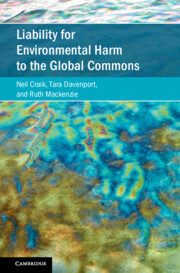Book contents
- Liability for Environmental Harm to the Global Commons
- Cambridge Studies on Environment, Energy and Natural Resources Governance
- Liability for Environmental Harm to the Global Commons
- Copyright page
- Contents
- Acknowledgements
- Table of Cases
- Table of Treaties and Instruments
- Abbreviations
- 1 Introduction
- 2 Purposes of, and Approaches to, International Liability
- 3 Definition and Valuation of Compensable Environmental Damage
- 4 Allocation of Liability for Environmental Harm in Areas beyond National Jurisdiction
- 5 Standards of Liability
- 6 Standing to Bring Claims for Environmental Harm in Areas beyond National Jurisdiction
- 7 Access to Remedies
- 8 Insurance and Compensation Funds
- 9 Conclusion
- Bibliography
- Index
6 - Standing to Bring Claims for Environmental Harm in Areas beyond National Jurisdiction
Published online by Cambridge University Press: 24 August 2023
- Liability for Environmental Harm to the Global Commons
- Cambridge Studies on Environment, Energy and Natural Resources Governance
- Liability for Environmental Harm to the Global Commons
- Copyright page
- Contents
- Acknowledgements
- Table of Cases
- Table of Treaties and Instruments
- Abbreviations
- 1 Introduction
- 2 Purposes of, and Approaches to, International Liability
- 3 Definition and Valuation of Compensable Environmental Damage
- 4 Allocation of Liability for Environmental Harm in Areas beyond National Jurisdiction
- 5 Standards of Liability
- 6 Standing to Bring Claims for Environmental Harm in Areas beyond National Jurisdiction
- 7 Access to Remedies
- 8 Insurance and Compensation Funds
- 9 Conclusion
- Bibliography
- Index
Summary
Environmental harm in areas beyond national jurisdiction (ABNJ) raises distinct issues of standing because of the collective nature of environmental interests in these areas, including who has the right (or obligation) to take the necessary response action to address environmental harm. Both international law and national law recognize that certain actors have sufficient legal interest to bring claims for environmental damage despite not directly suffering injury or loss. These developments reflect an increasing recognition of the intrinsic value of the environment and shifting conceptions of the environment as a collective good subjective to community interests. However, the parameters of the concepts that affirm collective interests in the protection of the environment are nebulous and the scenarios in which they would apply are likely to be contested. In considering the application of the rules of standing in ABNJ, this chapter explores trends in standing in relation to the environment under international law, civil liability regimes and national law before turning to how the specific regimes governing areas beyond national jurisdiction address the issue of standing.
- Type
- Chapter
- Information
- Liability for Environmental Harm to the Global Commons , pp. 159 - 198Publisher: Cambridge University PressPrint publication year: 2023



